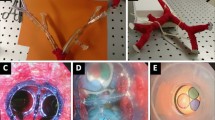Abstract
More than 500,000 flexible bronchoscopies are performed annually by chest physicians in the United States (Ernst et al., Chest 123:1693–1717, 2003). Indications include diagnosis of lung cancer and airway tumors, benign strictures, pulmonary infections, and treatment of central airway obstruction, emphysema, and intraepithelial lesions such as carcinoma in-situ. Anesthesiologists, cardiothoracic and trauma surgeons, otolaryngologists, and critical are physicians also perform this procedure as part of difficult airway management, intubation or airway inspection and bronchial toilet. Compared to the expanding body of simulation-related literature that is available in other procedural fields, however, the volume of published work relating to bronchoscopy is scant. The purpose of this paper is to provide an overview of the available literature pertaining to the use of simulation in bronchoscopy education, and to demonstrate how this limited yet valuable body of work lays a foundation for the future use of simulator-based bronchoscopy training.
Similar content being viewed by others
References
Alvarez, F., Burger, C., Grinton, S., et al. (2004). Competencies in pulmonary procedures. Chest, 125(2), 800–801.
Blum, M. G., Powers, T. W., & Sundaresan, S. (2004). Bronchoscopy simulator effectively prepares junior residents to competently perform basic clinical bronchoscopy. The Annals of Thoracic Surgery, 78(1), 287–291.
Bro-Nielsen, M., Tasto, J. L., Cunningham, R., et al. (1999). PreOp endoscopic simulator: A PC-based immersive training system for bronchoscopy. Studies in Health Technology and Informatics, 62, 76–82.
Chen, J. S., Hsu, H. H., Lai, I. R., et al., National Taiwan University Endoscopic Simulation Collaborative Study Group (NTUSEC) (2006). Validation of a computer-based bronchoscopy simulator developed in Taiwan. Journal of the Formosan Medical Association, 105(7), 569–576.
Colt, H. G., Crawford, S. W., & Galbraith, O. (2001). Virtual reality bronchoscopy simulation: A revolution in procedural training. Chest, 120(4), 1333–1339.
Crawford, S. W., & Colt, H. G. (2004). Virtual reality and written assessments are of potential value to determine knowledge and skill in flexible bronchoscopy. Respiration, 71(3), 269–275.
Davoudi, M., Osann, K., Murgu, S., et al. (2006). Systematic validation of two instruments to evaluate technical skills in flexible bronchoscopy using a virtual reality simulator. Chest, 130, 166S.
Davoudi, M., Quadrelli, S., Osann, K., et al. (2007). Creating a test of bronchoscopic knowledge using the Essential Bronchoscopist©: An initial concept demonstration study. Respirology (In print).
Di Domenico, S., Simonassi, C., & Chessa, L. (2007). Inexpensive anatomical trainer for bronchoscopy. Interactive Cardiovascular and Thoracic Surgery, 6, 567–569.
Ernst, A., Silvestri, G., Johnstone, D., & ACCP Interventional Chest/Diagnostic Procedures Network Steering Committee (2003). Interventional pulmonary procedures, guidelines from the American College of chest physicians. Chest, 123, 1693–1717.
Grober, E. D., Hamstra, S. J., Wanzel, K. R., et al. (2004). The educational impact of bench model fidelity on the acquisition of technical skill the use of clinically relevant outcome measures. Annals of Surgery, 240, 374–381.
Haponik, E. F., Russell, G. B., Beamis, J. F., et al. (2000). Bronchoscopy training: Current fellows’ experiences and some concerns for the future. Chest, 118(3), 572–573.
Issenberg, S. B., Mc Gaghie, W. C., Petrusa, E. R., et al. (2005). Features and uses of high-fidelity medical simulations that lead to effective learning: A BEME systematic review. Medical Teacher, 27(1):10–28.
Lund, M. E. (2006). Interventional pulmonology competency standards: The time is now. Journal of Bronchology, 13(1), 1–5.
Martin, M., Vashisht, B., Frezza, E., et al. (1998). Competency-based instruction in critical invasive skills improves both resident performance and patient safety. Surgery, 124(2), 313–317.
Matsumoto, E. D., Hamstra, S. J., Radomski, S. B., et al. (2002). The effect of bench model fidelity on endourological skills: A randomized controlled study. The Journal of Urology, 167, 1243–1247.
Moorthy, K., Smith, S., Brown, T., et al. (2003). Evaluation of virtual reality bronchoscopy as a learning and assessment tool. Respiration, 70(2), 195–199.
Ost, D., DeRosiers, A., Britt, E. J., et al. (2001). Assessment of a bronchoscopy simulator. American Journal of Respiratory and Critical Care Medicine, 164(12), 2248–2255.
Ouellette, D. R. (2006). The safety of bronchoscopy in a pulmonary fellowship program. Chest, 130, 1185–1190.
Pastis, N., Nietert, P., Silvestri, G., & ACCP Interventional Chest/Diagnostic Procedures Network Steering Committee (2005). Variation in training for interventional pulmonary procedures among US pulmonary/critical care fellowships, a survey of fellowship directors. Chest, 127, 1614–1621.
Prakash, U. B. S. (2003). Guidelines for training and practice of interventional pulmonology. By the numbers? Journal of Bronchology, 10, 169–173.
Ram, B., Oluwole, M., Blair, R. L., et al. (1999). Surgical simulation: An animal tissue model for training in therapeutic and diagnostic bronchoscopy. The Journal of Laryngology and Otology, 113(2), 149–151.
Rowe, R., & Cohen, R. A. (2002). An evaluation of a virtual reality airway simulator. Anesthesia and Analgesia, 95(1), 62–66.
Scott, D. J., Bergen, P. C., Rege, R. V., et al. (2000). Laparoscopic training on bench models: Better and more cost effective than operating room experience? Journal of the American College of Surgeons, 191(3), 272–283.
Sedlack, R. E., Kolars, J. C., & Alexander, J. A. (2004). Computer simulation training enhances patient comfort during endoscopy. Clinical Gastroenterology and Hepatology, 2(4), 348–352.
Seymour, N. E., Gallagher, A. G., Roman, S. A., et al. (2002). Virtual reality training improves operating room performance – results of a randomized, double-blinded study. Annals of Surgery, 236(4), 458–464.
Tasto, J. L., Verstreken, K., Brown, J. M., et al. (2000). PreOp endoscopy simulator: From bronchoscopy to ureteroscopy. Studies in Health Technology and Informatics, 70, 344–349.
Torrington, K. G. (2000). Bronchoscopy training and competency: How many are enough? Chest, 118(3), 572–573.
Author information
Authors and Affiliations
Corresponding author
Additional information
An erratum to this article can be found at http://dx.doi.org/10.1007/s10459-008-9108-4
Rights and permissions
About this article
Cite this article
Davoudi, M., Colt, H.G. Bronchoscopy simulation: a brief review. Adv in Health Sci Educ 14, 287–296 (2009). https://doi.org/10.1007/s10459-007-9095-x
Received:
Accepted:
Published:
Issue Date:
DOI: https://doi.org/10.1007/s10459-007-9095-x




